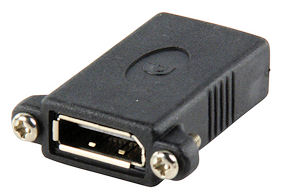

So how does chroma subsampling work? To understand chroma subsampling, it’s important to understand the Y'CbCr color space it operates on. In any case, the use of chroma subsampling is as old as color television, however its use in anything approaching mainstream monitors is much newer.

I’ve seen it referred to compression at some points, and while the concept is indeed similar it’s important to note that chroma subsampling doesn’t try to recover lost color information nor does it even intelligently discard color information, so it’s perhaps thought better as a semi-graceful means of throwing out color data.

In a nutshell, chroma subsampling is a means to reduce the amount of chroma (color) data in an image, allowing images and video data to either be stored in less space or transmitted over constrained links.
#Displayport 1.4 bandwidth Pc#
Chief among these is support for chroma subsampling.Ĭhroma subsampling is a term that has become a little better known in the last few years, but the odds are most PC users have never really noticed the technique. DisplayPort BandwidthĪs a result, for these first generation of monitors at least, NVIDIA has resorted to a couple of tricks to make a 144Hz 4K monitor work within the confines of current display technologies. Meanwhile when using HDR paired with the P3 color space, where you’ll almost certainly want 10bpc color, there’s only enough bandwidth to drive it at 98Hz. Notably, this isn’t enough bandwidth for any higher refresh rates, particularly not 144MHz. Still, the combination of high refresh rates, high bit depths, and HDR metadata pushes the bandwidth requirements much higher than DisplayPort 1.4 can handle.Īll told, DisplayPort 1.4 was designed with just enough bandwidth to support 3840x2160 at 120Hz with 8bpc color, coming in at 25.81Gbps of 25.92Gbps of bandwidth. DisplayPort 1.3/1.4 increased this to just shy of 26Gbps of video data, which is a rather significant amount of data to send over a passive, two-meter cable. One of the key elements that even makes G-Sync HDR monitors possible – and yet still holds them back at the same time – is the amount of bandwidth available between a video card and a monitor. When DisplayPort 1.4 Isn’t Enough: Chroma Subsampling


 0 kommentar(er)
0 kommentar(er)
